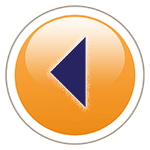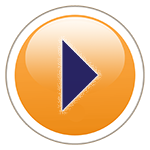Book choices for today:
Birds Build Nests Elaine Pascoe
Have You heard the Nesting Bird? Rita Gray
Craddles in Trees Patricia Demuth
Bird Nests Therese Hopkins
Housing Dean Spaulding
Even an Ostrich Needs a Nest Irene Kelly
Mama Built a Little Nest Jennifer Ward
Oliver’s Vegetables Vivian French
No More Vegetables Nicole Rubel
Zoology: (first circle)
Need for lesson – A real bird nest or a picture of one and pictures of baby birds in a nest.
Zoology 17
A bird nest is the spot in which a bird lays and incubates its eggs and takes care of the baby birds. Not every bird makes a nest for its eggs, but most of them do. Birds use many different things to make a nest with. Some birds use things like mud, sticks, feathers, strings, grass, and pine needles. Birds build their nest in a variety of places. We often think of a tree for bird nest. Many birds do use trees, but nests sometimes are built on the ground, or maybe the bird chooses a part of your house to build their nest! People also like to make bird houses that birds will use for their eggs.
A mother bird will lay her eggs and incubate them. This is the period of time when the birds inside of the eggs are growing, and the eggs have to be kept warm and protected. This happens until the babies hatch. Bird eggs come in different sizes and colors. Some eggs are blue, brown, and white. Sometimes the eggs have speckles or spots on them. They can be very pretty.
Inside of the egg the tiny bird lies curled up in a ball. Its eyes are closed. All of the food it will need is inside of the egg. The baby bird grows until it fills the whole inside of the egg. then it is ready to hatch. On the baby birds bill, or beak is a tiny tooth. The bird will use this tooth to help him come out of the egg. It scrapes the tooth against the egg shell to crack it open and slowly the bird will hatch out of its egg. The baby birds will be hungry, so now the parents are going to be very busy feeding and taking care of the baby birds. Speaking of parents. Male or father birds and females, mother birds, often look different from each other. They are similar looking, but usually have different color feathers. Male birds are usually the more colorful pretty ones.
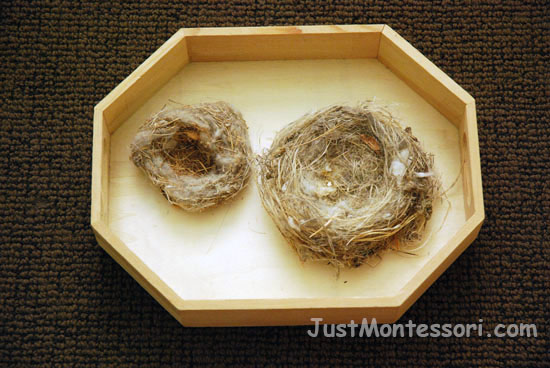
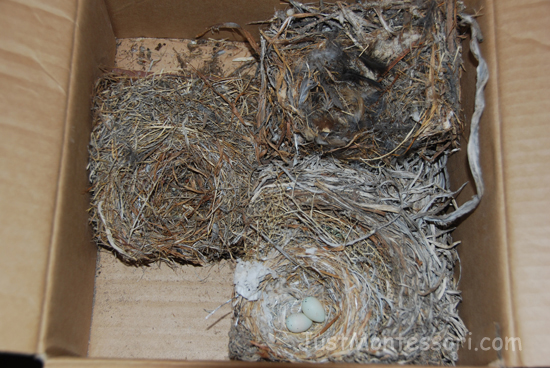

Additional Works:
Parts of an Egg – Older children may enjoy learning about the parts of an egg. I made it from a worksheet.
Egg Counting – These nests and eggs are from a craft store. I made little numbers and hot-glued them to the nests.
Bird House Matching – These are from childcareland.com. I colored them and made them into a matching work.
Male-Female Bird Matching – These were from a child’s zoo/animal type magazine. Children have to match the male and female birds. Backs are color-coded for control of error.
Bird Hatching Sequence – I made these cards from pictures in a magazine.
Make Way for Ducklings – A great idea for another lesson on birds and finding the right spot for a nest. Read and discuss the book, Make Way for Ducklings. Follow-up with activites.
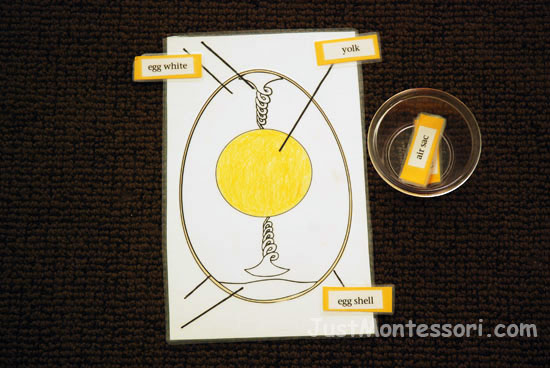
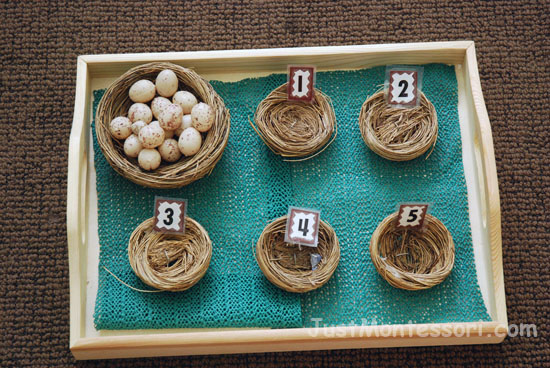
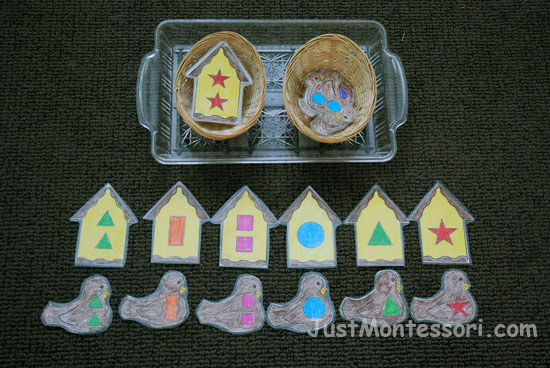
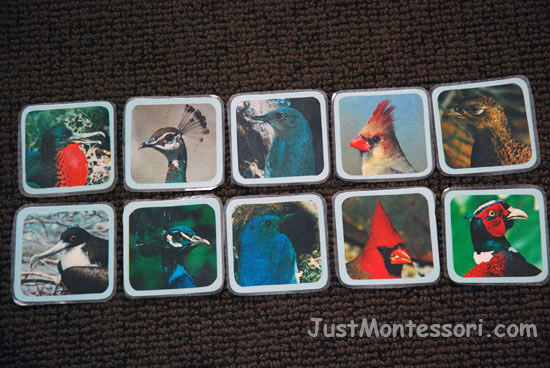
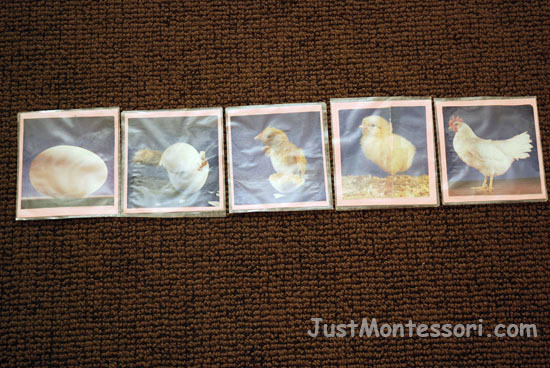
Practical Life:
Bird Transfer – Children can use tongs to transfer these little birds from one nest to the other.
Open and Close – These are plastic eggs that the children can open and close. I put a duck inside each one.
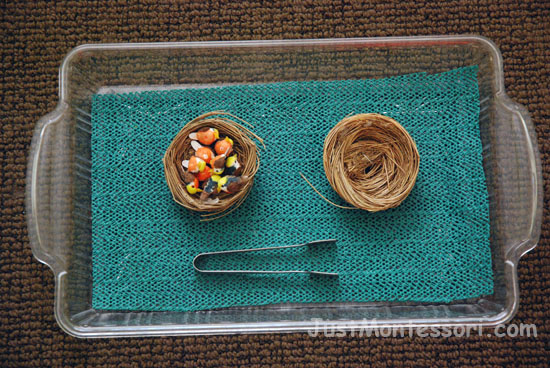
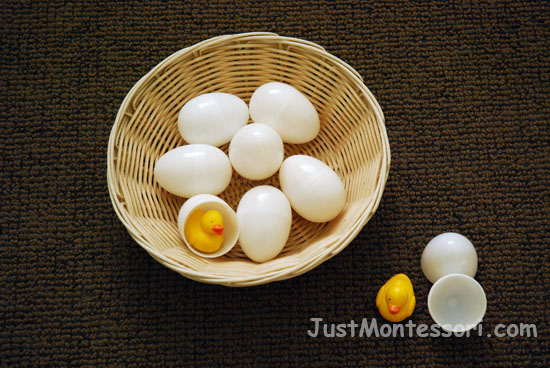
Art:
Bird Nests – Provide small brown paper lunch bags. Children fold them down to shape a nest. Have twigs, leaves, feathers, strings, etc. for the children to glue around the nest shape bags. Pom-poms are glued inside for the baby birds with beaks and eyes.
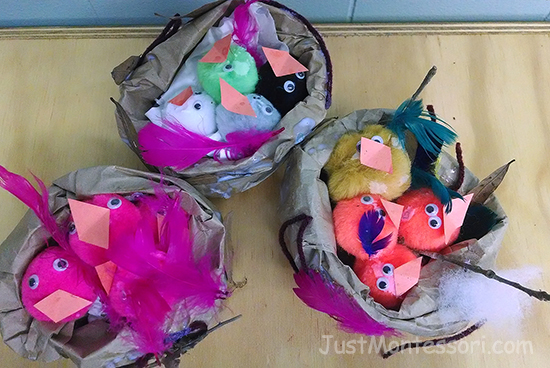

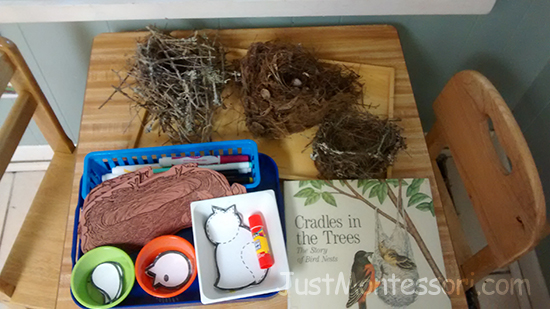
Songs/Poems:
Bird Names Game – Provide a variety of different bird pictures. Learn the names of the birds. Then play “Look and See”. Children close their eyes and you remove a bird picture. Children will then guess which bird is missing. This can be a circle time game, small group game.
“Look and see, do you know me?” (close eyes, remove a bird)
then, “Hey, hey, hey, who flew away?”
Science: (second circle)
Need for lesson – Vegetable vocabulary cards: peas, corn, potato, and the onion.
Science 27
We talked about vegetables and that when we eat them, we are actually eating a part of the plant. If we eat celery which part of the plant is that? How about a carrot? If we eat cauliflower we are eating the_____? What part of the plant am I eating if I eat spinach and lettuce?
Some other vegetables that we eat are the seeds of the plant. When we eat corn or peas we are eating the seeds of those plants.
A potato is a vegetable that grows under the ground. It is not the root though. It is a special part of the potato plant – a tuber.
Another tricky vegetable is an onion. It grows under the ground but it is not a root or a tuber. It is a bulb. Remember we talked a little bit about bulbs, and we planted some? An onion is a vegetable that we eat and grows under the ground. It is a bulb vegetable not a root one.
So tubers and bulbs are tricky vegetables!
Art:
Vegetable Prints – Provide paints and a variety of vegetables and fruits that have been cut for children to make prints with. Review which ones are fruits and why.

Song (CD) choices for today:
Potato Bon Appetit
Eat Good Food Exercise – Janet & Judy
Egg to Chick Animals – Macmillan
Mother Gooney Bird Dr. Jean
Let’s Go to Market Frank Leto
Buy Weeks 11-14 PDF
-
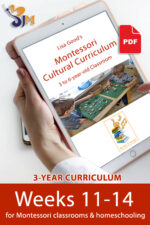 (D) Weeks 11-14$25.00
(D) Weeks 11-14$25.00

